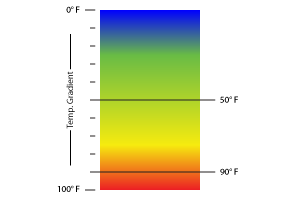 The speed of sound through the air changes about 0.18% for every 1° C. Because ultrasonic sensors use sound waves to detect their target, they are affected by temperature change. This is typically not a problem, for APG sensors at least, as we install temperature sensors near the transducer for automatic compensation.
The speed of sound through the air changes about 0.18% for every 1° C. Because ultrasonic sensors use sound waves to detect their target, they are affected by temperature change. This is typically not a problem, for APG sensors at least, as we install temperature sensors near the transducer for automatic compensation.
If, however, you have a large difference between the temperature at the transducer, and the temperature at the target, performance can be negatively affected. We call this a temperature gradient. The speed of sound will change as the sound wave travels closer to the target, and then normalize as the echo approaches the sensor. With an inconsistent speed of sound, the sensor is incapable of reading an accurate distance.
The following application example will demonstrate this effect, and offer a few recommendations on how to help minimize the potential for erratic readings.
An ultrasonic sensor is used to calculate the flow of a mountain river, and is mounted inside a 5 ft. stilling well. The water is very cold, approximately 50° F. However, the sensor can reach 90° F or higher during the day as the sun heats the top of the stilling well.
The sensor’s readings are stable and accurate at cooler temperatures, but as the ambient air heats up during the day, the readings become erratic and inaccurate. As the temperature cools in the evening the readings return to normal.
Due to the high ambient temperature and the 40° F swing of the temperature gradient, the sensor’s readings change throughout the day.
Following these recommendations is a good start to help counter the effect of temperature on your sensor so you can have reliable readings all year round.
If the problem persists, there are other technologies you could use to prevent the issue in the future. Contact us to learn about what types of sensors would work well when you’re experiencing a temperature gradient.